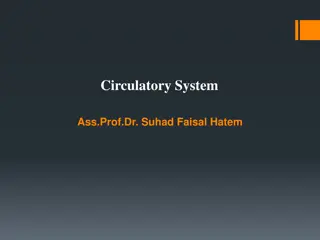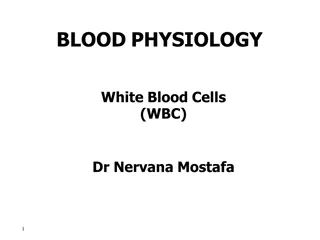Understanding White Blood Cells and Their Classification
White blood cells (WBCs), or leukocytes, are vital elements of the blood responsible for protecting the body against invading organisms. They are classified into granulocytes (neutrophils, eosinophils, basophils) and agranulocytes (monocytes, lymphocytes), each playing specific roles in the immune system. Neutrophils are known for their multilobed nucleus and phagocytic nature, eosinophils have coarse granules and a bilobed nucleus, basophils have purple-blue staining granules, and monocytes are the largest WBCs with a variety of nucleus shapes.
Download Presentation

Please find below an Image/Link to download the presentation.
The content on the website is provided AS IS for your information and personal use only. It may not be sold, licensed, or shared on other websites without obtaining consent from the author. Download presentation by click this link. If you encounter any issues during the download, it is possible that the publisher has removed the file from their server.
E N D
Presentation Transcript
White blood cells (WBCs) or leukocytes are the colorless and nucleated formed elements of blood (leuko = white or colorless). Compared to RBCs, the WBCs are larger in size and lesser in number. Yet functionally, these cells are as important as RBCs and play very important role in defense mechanism of body by acting like soldiers and protecting the body from invading organisms.
CLASSIFICATION 1. Granulocytes with granules. i. Neutrophils granules take both acidic and basic stains ii. Eosinophils granules take acidic stain. iii. Basophils granules take basic stain. 2. Agranulocytes without granules. i. Monocytes . ii. Lymphocytes.
NEUTROPHILS 1-Neutrophils are also known as polymorph nuclear leukocytes because the nucleus is multilobed. 2-The number of lobes varies from 1 to 6. 3-The granules are fine or small in size. When stained with Leishman s stain (which contains acidic eosin and basic methylene blue), the granules take both the stains equally. So, the granules appear violet in color. 4-The diameter of cell is 10 to 12 . The neutrophils are ameboid and phagocytic in nature.
EOSINOPHILS 1-Eosinophils have coarse (larger) granules in the cytoplasm, which stain pink or red with eosin. 2-the nucleus is bilobed and spectacle shaped. 3-Rarely trilobed nucleus may be present. The diameter of the cell varies between 10 and 14
BASOPHILS 1-Basophils also have coarse granules in the cytoplasm and the granules stain purple blue with methylene blue. 2-Nucleus is bilobed. Diameter of the cell is 8 to 10 .
MONOCYTES 1-Monocytes are the largest WBCs with diameter of 14 to 18 . 2-The cytoplasm is clear without granules. The nucleus is round, oval, horseshoe shaped, bean shaped or kidney shaped. 3-The nucleus is placed either in the center of the cell or pushed to one side and a large amount of cytoplasm is seen.
LYMPHOCYTES 1-Lymphocytes also do not have granules in the cytoplasm. 2-The nucleus is spherical shaped and occupies the whole of the cytoplasm. 3-A rim of cytoplasm may or may not be seen.
Depending upon the size, the lymphocytes are divided into two types: i. Large lymphocytes younger cells with a diameter of 10 to 12 ii. Small lymphocytes older cells with a diameter of 7 to 10 . Depending upon the function, the lymphocytes are divided into two types: i. T lymphocytes concerned with cellular immunity ii. B lymphocytes concerned with humoral immunity.
NORMAL LEUKOCYTE COUNT Total WBC count (TC): 4,000 to 11,000/cu mm of blood VARIATIONS IN LEUKOCYTE COUNT WBC count varies both in physiological and pathological conditions. Increase in WBC count is called leukocytosis and decrease in the count is called leukopenia. The term leukopenia is generally used only conditions. for pathological
PROPERTIES OF WBCs 1. Diapedesis Diapedesis is the process by which the WBCs squeeze through the narrow blood vessels. 2. Ameboid Movement Neutrophils, monocytes and lymphocytes show amebic movement characterized by protrusion of the cytoplasm and change in the shape. 3. Chemotaxis Chemotaxis is the attraction of WBCs towards the injured tissues by the chemical substances released at the site of injury. 4. Phagocytosis Neutrophils and monocytes engulf the foreign bodies by means of phagocytosis.
FUNCTIONS OF WBCs Generally, WBCs play an important role in defense mechanism. These cells protect the body from invading organisms or foreign bodies either by destroying or inactivating them. However, in defense mechanism, each type of WBCs acts in a different way.
NEUTROPHILS Along with monocytes, the neutrophils provide the first line of defense against the invading microorganisms. Neutrophils wander freely all over the body through the tissue.
Mechanism of Action of Neutrophils Neutrophils are released in large number from the blood. At the same time, new neutrophils are also produced from the progenitor cells. All the neutrophils move by diapedesis towards the site of infection by means of chemotaxis. The chemotaxis occurs due to the attraction by some chemical substances called chemoattractants, which are released from the infected area. After reaching the area, the neutrophils surround the area and get adhered to the infected tissues. The chemoattractants increase the adhesive nature of neutrophils so that all the neutrophils become sticky and get attached firmly to the infected area. Each neutrophil can hold about 15 to 20 microorga-nisms at a time. Now, the neutrophils start destroying the invaders. First, these cells engulf the bacteria and then destroy them by means of phagocytosis
Pus and Pus Cells Pus is the whitish-yellow fluid formed in the infected tissue. During the battle against the bacteria, many WBCs are killed by the toxins released from the bacteria. The dead cells are collected in the center of infected area. The dead cells together with plasma leaked from the blood vessel, liquefied tissue cells and RBCs escaped from damaged blood constitute the pus. vessel (capillaries)
EOSINOPHILS The eosinophils provide defense to the body by acting against the parasitic infections and allergic conditions like asthma. Eosinophils are responsible for detoxification, disintegration and removal of foreign proteins.
Mechanism of Action of Eosinophils The eosinophils attack the invading organisms by secreting some special type of cytotoxic substances. These substances become lethal and destroy the parasites. Some of these substances are: 1. Eosinophil peroxidase 2. Major basic protein (MBP) 3. Eosinophil cationic protein (ECP) 4. Eosinophil derived neurotoxin 5. Interleukin-4 and interleukin-5
BASOPHILS The basophils play an important role in healing processes and acute hypersensitivity reactions (allergy). Mechanism of Action of Basophils: The basophils execute the functions by releasing some important substances from their granules such as: 1. Heparin which is essential to prevent the intra-vascular blood clotting 2. Histamine, bradykinin and serotonin which produce the acute hypersensitivity reactions by causing vascular and tissue responses. 3. Proteases and myeloperoxidase that exaggerate the inflammatory responses. 4. Interleukin-4 which accelerates inflammatory responses and kill the invading organisms.
Mast Cell Mast cell is a large tissue cell resembling the basophile. Usually these cells are found along with the blood vessels and do not enter the blood stream. These cells are predominantly seen in the areas such as skin, mucosa of the lungs and digestive tract, mouth, conjunctiva and nose. Functions The mast cells function along with basophils and produce hypersensitivity reactions like allergy and anaphylaxis. These cells act by secreting some substances like histamine, heparin, serotonin, hydrolytic enzymes, proteoglycans, chondroitin sulphates, arachidonic acid derivatives such as leukotriene C (LTC) and prostaglandin.
MONOCYTES Monocytes are the largest cells among the WBCs. Like neutrophils, monocytes also are motile and phagocytic in nature. These cells wander freely through all tissues of the body and provide the first line of defense along with neutrophils. Monocytes are the precursors of the tissue macrophages. The matured monocytes stay in the blood only for few hours. Afterwards these cells enter the tissues from the blood and become tissue macrophages. Examples are Kupffer cells in liver, alveolar macrophages in lungs and macrophages in spleen. Monocytes act by secreting certain sub-stances like interleukin-1 (IL-1), colony stimulating factor (M-CSF) and platelet activating factor (PAF). of tissue macrophages
LYMPHOCYTES The lymphocytes are responsible for development of immunity. Lymphocytes are classified into two categories namely T lymphocytes and B lymphocytes. Leukopoiesis is the development and maturation of WBCs (Fig.1).
FACTORS NECESSARY FOR LEUKOPOIESIS Leukopoiesis is influenced by hemopoietic growth factors and colony stimulating factors. Colony Stimulating Factors The colony stimulating factors (CSF) are proteins which cause the formation of colony forming blastocytes. Colony stimulating factors are of three types: 1. Granulocyte CSF (G-CSF) secreted by monocytes and endothelial cells 2. Granulocyte Monocyte CSF (GM-CSF) secreted by monocytes, endothelial cells and T lymphocytes 3. Monocyte CSF (M-CSF) secreted by monocytes and endothelial cells.























